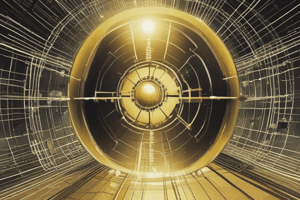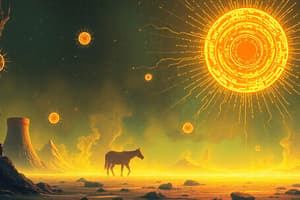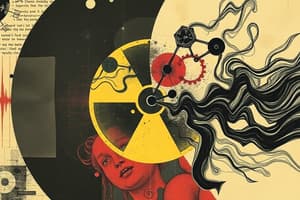Podcast
Questions and Answers
Who identified radioactivity and shared the Nobel Prize in 1903?
Who identified radioactivity and shared the Nobel Prize in 1903?
- Wilhelm Röntgen
- Albert Einstein
- Henri Becquerel (correct)
- Marie and Pierre Curie
What is the charge of a positron, a type of beta particle?
What is the charge of a positron, a type of beta particle?
- -1
- +1 (correct)
- +2
- 0
Which type of radiation has no mass or charge?
Which type of radiation has no mass or charge?
- Beta
- Gamma (correct)
- Electron
- Alpha
How does the half-life of a radioactive isotope relate to its decay?
How does the half-life of a radioactive isotope relate to its decay?
Which detection tool is specifically designed to measure radiation quantitatively?
Which detection tool is specifically designed to measure radiation quantitatively?
Which radiation type is the least penetrating and can be stopped by paper?
Which radiation type is the least penetrating and can be stopped by paper?
What is the consequence of radiation exposure at 600 rem?
What is the consequence of radiation exposure at 600 rem?
Which of the following is a stable isotope characteristic?
Which of the following is a stable isotope characteristic?
Flashcards
Radioactivity
Radioactivity
The spontaneous emission of particles or energy from the nucleus of an unstable atom.
Alpha decay
Alpha decay
The emission of an alpha particle (helium nucleus) from an unstable nucleus, decreasing atomic number by 2 and mass number by 4.
Beta decay
Beta decay
A type of radioactive decay in which a neutron changes into a proton and emits an electron.
Gamma decay
Gamma decay
Signup and view all the flashcards
Half-life
Half-life
Signup and view all the flashcards
Stable isotope
Stable isotope
Signup and view all the flashcards
Radiation sickness
Radiation sickness
Signup and view all the flashcards
Radiation Dosimetry
Radiation Dosimetry
Signup and view all the flashcards
Study Notes
Radioactivity
- Key figures in the discovery of radioactivity include Wilhelm Röntgen (X-rays), Henri Becquerel (identified radioactivity in 1896), and Marie and Pierre Curie (named the phenomenon and shared the 1903 Nobel Prize)
- Radioactivity is the phenomenon of the spontaneous emission of radiation
Types of Radiation
- Alpha (α): Helium nuclei (2 protons, 2 neutrons), carrying a +2 charge
- Beta (β): Electrons with a -1 charge or positrons (β+) with a +1 charge
- Gamma (γ): High-energy electromagnetic radiation; no mass or charge
Radioactivity Details
- Wavelength and frequency (λ and ν) are inversely related (λ=c/ν).
- Gamma rays have high energy and are invisible to the human eye.
Nuclear Radiation
- Stable isotopes (264 naturally occurring types of stable isotopes).
- Radioactivity in isotopes with imbalance in proton-to-neutron ratio.
- Types of decay
- Beta Emission: Neutron turns into a proton and an ejected electron
- Alpha Emission: Helium nucleus ejection reducing atomic number by 2 and mass number by 4.
- Positron Emission: Proton turns into a neutron and an ejected positron
- Gamma Emission: High energy state -> ground state, no change in atomic/mass numbers
- Electron Capture: Nucleus captures an electron reducing atomic number by 1.
Half-Life
- Time taken for half of a radioactive sample to decay
- Examples: Iodine-131 decays via beta and gamma emissions.
Measuring Radioactivity
- Detection tools to measure radiation exposure
- Dosimeters
- Geiger counters
- Scintillation counters
Penetration Power
- Alpha: Least penetrating, stopped by paper
- Beta: Penetrates paper, stopped by thin lead
- Gamma: Highly penetrating, stopped by thick lead
Radiation Dosimetry
- Effects of radiation exposure
- 25 rem: Whole-body exposure, noticeable in blood count
- 100 rem: Symptoms of radiation sickness
- 400 rem: Death within a month in 50% of exposed individuals
- 600 rem: Almost always fatal within a month
- 50,000 rem: Required to kill bacteria
- 1,000,000 rem (10^6 rem): Required to inactivate viruses
- 100 rem: Radiation sickness
- 600 rem: Lethal dose within a month
Nuclear Medicine
- Use of radionuclides for diagnosis and treatment
Nuclear Fusion
- Process: Fusing light nuclei (e.g., hydrogen) into heavier ones (e.g., helium).
- Applications: Energy source in stars and creation of transuranium elements
Nuclear Fission
- Process: Splitting heavy nuclei (e.g., Uranium-235) into smaller ones, releasing energy.
- Applications: Controlled nuclear reactors and uncontrolled nuclear weapons
- Waste Management: Spent fuel disposal at sites like Yucca Mountain
Studying That Suits You
Use AI to generate personalized quizzes and flashcards to suit your learning preferences.




